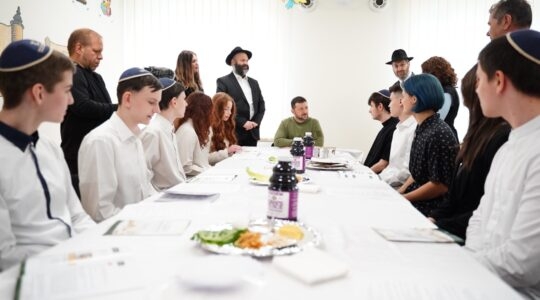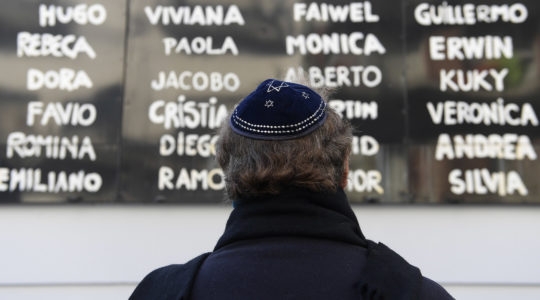CARTAGENA, Colombia (JTA) — Luis Alberto Prieto Vargas appears to be a Jew.
He wears a kipah, he introduces himself as Jewish and two years ago Vargas, a Christian by birth, underwent a conversion ceremony to Judaism following several years of religious study.
It all began seven years ago when Vargas, now 51, became part of a movement in Bogota of religious seekers.
“As I did, most of the people involved came from Christian roots,” he said. “And we found in Judaism an answer to our inquiries.”
But Vargas’ conversion hit a key snag: Jews.
First, Orthodox Jews in Colombia refused to accept Vargas and 200 or so others as would-be Jews, vehemently disavowing association with them and refusing them access to the community’s mikvahs for conversion.
The group, which calls itself Maim Haim — Hebrew for “living waters” — turned to religious authorities in Israel for training and, they hoped, eventual conversion, but it was stymied when Colombia’s Orthodox Jewish leadership contacted rabbinic authorities in Israel and warned them against accepting the would-be converts.
Main Haim eventually found a rabbi in Israel willing to teach its members, and in 2007 the rabbi and two colleagues convened a Jewish religious court, or bet din, and converted 104 of them, including Vargas.
Still, many Jewish institutions in Colombia refuse to accept them as members.
The plight of Main Haim underscores the difficulty many converts and would-be converts to Judaism have in Latin America, particularly those who convert as a group or come to Judaism on their own rather than in concert with local Jewish authorities.
Local Jewish communities are concerned about being overwhelmed by mass converts, and many have questions about whether the converts’ motivations are genuine. In Israel and in Colombia, the converts often are viewed skeptically — as emigres-in-waiting more interested in obtaining Israeli citizenship, which is available to all Jews, than Judaism itself.
Approximately 70 percent of Maim Haim members have filed petitions for aliyah with the Jewish Agency for Israel. Their petitions are being held in abeyance while Israel’s Chief Rabbinate makes a determination as to their Jewish credentials.
“There should be a filter,” said Colombia’s chief rabbi, Alfredo Goldschmidt.
He said the country is witnessing an “explosion” of groups hoping to convert. Colombia has about 4,000 Jews.
When he first arrived in Bogota in 1974, Goldschmidt said, he would get about one call per month from someone interested in converting. By 1996, the rabbi said, the rate had jumped to one per week. About seven years ago it was up to two to three calls per week.
Goldschmidt says the Internet has fueled interest in Judaism. Some conducting their spiritual quests online are coming across rabbis who offer services on the Web.
Last December, members of Colombia’s nine Jewish communities gathered to debate mass conversions and how to handle them.
“Latin American Jewish communities are not prepared for the challenge of mass conversions,” said Marcos Peckel, president of the Colombian Jewish Community Confederation, the umbrella organization for Colombian Jewry.
There are cases now, he said, “in which people going through conversion processes are larger than the traditional Jewish community itself. This would significantly alter the community’s life.”
For the time being, Main Haim members have been keeping Jewish traditions — acquiring a Torah scroll, holding bar mitzvah ceremonies and importing a mohel from Venezuela when there is a newborn to circumcise. Denied access to the mikvah in Bogota, the congregation uses a river outside of Bogota as its ritual bath.
Peckel says each Jewish institution must decide whether or not to accept Maim Haim congregants as members. He notes that the group’s members have not asked to join Colombia’s main Jewish institutions.
“They decided to convert themselves as a group and establish their own community,” Peckel told JTA. “They didn’t convert to join our communities. Also, they were converted by Israeli rabbis without consulting the Colombian Jewish communities.”
Gradually, however, the Maim Haim community has gained some legitimacy.
About six months ago, a Jewish community center in Bogota offered the group some space and invited the community to Yom Hashoah and Yom Ha’atzmaut celebrations.
A few weeks ago, Maim Haim members joined a class taught by a local rabbi.
“Little by little, the community’s doors have started to open to us,” said Vargas, whose son and two other members of Maim Haim are studying at a yeshiva in Israel.
“It is unfortunate the rejection of Maim Haim and other groups that go through the whole conversion process are still not received in their city’s synagogues,” said Jaime Eisenband, president of a Colombian Jewish institution, the Baranquilla Philanthropic Israeli Center. “I honestly see it more as a social issue than religious. Despite the brave standpoint of some Colombian Orthodox rabbis saying they should be received as Jews, the community leadership still keeps them out.”
Vargas discussed the difficulties of converts and would-be converts in Colombia and Peru at last month’s conference for Latin American and Caribbean Jewish community leaders. Organized by the American Jewish Joint Distribution Committee, the conference took place in Cartagena.
At the conference, Rabbi Guillermo Bronstein of Peru, one of Lima’s three rabbis, said the issue of conversions is a political one that needs to be dealt with by the community as a whole.
“We have to be humble,” Bronstein said. “Instead of judging the people wanting to be Jewish, we should put ourselves in their shoes.”





